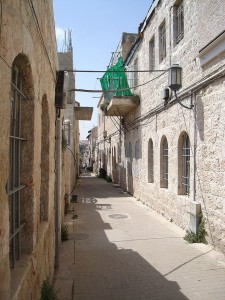Everyone discussing Monsey and Jersey City knows gentrification is the root problem.

Credit: Footballkickit via Wikimedia Commons
Jerusalem, January 13 – The historic neighborhood of Nachlaot in the center of this city has seen numerous demographic shifts in its decades-long transition from slum to hipster, yet despite the phenomenon as the obvious root cause of stabbing and shooting attacks in New York and New Jersey, law enforcement officials expressed puzzlement this week at the mysterious lack of such crimes here.
Police officials scratched their collective heads at a meeting this week with residents, where they admitted they simply cannot account for the absence of violent murders sparked by the neighborhood’s gentrification. Moriah District Deputy Chief Dam Yehudi-Hefker informed attendees that the axiomatic link between rising real estate prices and the murder of Jews appears not to affect Nachlaot’s development, a fact that defies predictions.
“Everyone discussing Monsey and Jersey City knows gentrification is the real problem,” he stated, referring to stabbing and shooting attacks on Orthodox Jews that left three dead and many more injured. “All the social activists made that clear. It couldn’t be just antisemitism; that would be absurd. With that in mind we’ve been looking at the crime statistics for Nachlaot, and for other Jerusalem neighborhoods in the throes of gentrification, and we’re not seeing the violence that the phenomenon produces in the New York area. We’re flummoxed.”
The current neighborhood of Nachlaot evolved from walled-in settlements outside the Old City beginning in the 1870’s, as overcrowding, disease, and other urban ailments drove residents and Jewish philanthropists to seek solutions that provided relief. In the many decades since, the separate walled communities grew together into a larger amalgam, but for most of its existence Nachlaot remained a bastion of low-income families living barely over subsistence level. Influxes of immigrants from Arab and Muslim countries that expelled them during the State of Israel’s infancy added to the mix. The low rent and dilapidated apartments also attracted students and foreign workers on a limited budget, further diversifying the polity. But beginning in the 1990’s, wealthier buyers and developers identified the immense potential of Nachlaot’s location smack dab in the middle of the city, a five-minute walk from the bustling downtown, just as the second or third generation of longtime residents began to seek more spacious neighborhoods, or other places in Israel entirely, to raise their own families. Nevertheless, not a single stabbing or shooting – or murder of any sort, police report – has accompanied this trend, and both police and experts remain baffled.
“Maybe the law of averages will catch up,” mused a municipal official. “There is certainly no shortage of folks not too far east of here who would enjoy enthusiastic participation in an effort to bring the stabbing and shooting statistics in line with what’s expected.”
Please support our work through Patreon.




